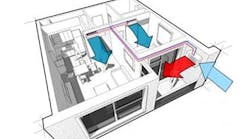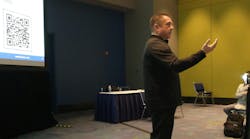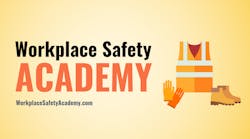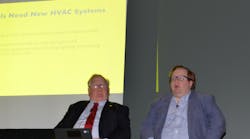By Tex McLeod
As the HVAC and building industries endeavor to build and retrofit homes with improved efficiency systems, improved comfort systems, and state-of-the-art Indoor Air Quality (IAQ), certain natural concepts must be considered. These concepts are related to the physics of how heating, air, and moisture move in and out of a building.
If HVAC contractors and home builders familiarize themselves with these concepts, and better understand how heat, air, and moisture move through a home, they’ll make more meaningful improvements to new and existing homes.
The “House as a System” approach increases the industry’s chances of modifying and building houses that provide improved comfort, ventilation, and IAQ.
A Furnace is Not an Island
When a furnace connected to a chimney is removed from a home, you remove a portion of the ventilation system. Because every time the furnace runs, you use air from within the home to vent the products of combustion. Although some of that existing house air passes up and out of the house through the chimney, you also used a lot of house air in the process.
When air is removed from a building, air usually leaks in to replace it. So indirectly, every time your furnace runs, it becomes part of the ventilation system. Why do we need to improve ventilation? Because rising energy costs, changing codes, and increased insulation are resulting in tighter buildings. The combination of increasingly airtight buildings without chimneys predicates a need for more supplemental ventilation.
Return air (supply ventilation) is one source of fresh, replacement air. Another method is to exhaust air from bathrooms and kitchens, which we refer to as “source removal.”
The Challenge of Tighter Homes
As the construction industry works to build tighter homes, contractors are sealing up leaks in existing homes. So you have to wonder where the new air will come from. It has to find a way in, and used air has to find a way out.
Increased tightness and insulation puts pressure on the HVAC industry to continue to deliver and develop efficient methods of ventilation. This addresses the energy used to run the equipment, and the means by which it recovers energy from the stale air. We need to move toward “balanced ventilation,” or, “putting the V back in HVAC.”
We live and work in a world governed by codes. In the building industry, codes generally work well, but may also need to be integrated with related guidelines from other industries. We have effective codes that help us build better buildings, but they should also relate in some way to HVAC concepts, such as the furnace example mentioned earlier. Then, we can tie buildings and energy programs together by code, by building materials used, and increasingly, by energy performance testing, such as blower door testing.
Partners in HVAC Progress
I think we can all agree that now and into the future, HVAC technicians will be installing systems into significantly tighter houses. We must match the skills and objectives of home building trades so builders receive correctly designed HVAC systems for the houses they’re building.
Those HVAC contractors who have been installing the same systems they’ve always relied on (it’s often easier to do what you’ve done for years) will be surprised by the dramatic changes that are upon us. Once we’re past this current energy and housing crisis, I don’t think anyone will look at housing the same way again.
The Coming Fallout
Once the housing crisis dust has cleared, a significant amount of unoccupied housing will be on the market. “Health-friendly,” energy efficient houses will be one of the means by which builders can differentiate themselves and retain market share. Will builders do the unexpected, and reenter newly built but empty homes to make IAQ improvements?
There are, and will be, many HVAC niches that offer opportunities for growth that extend beyond low price. HVAC contractors who install basic systems into standard production housing where “price rules” don’t really design. They do the quickest installation at the lowest price to the builder. If HVAC contractors offer options that builders can understand, they’ll be providing more tools to help builders sell more houses.
Building America: Teamwork in Action
Building America (BA) is a partnership of building industry segments sponsored by the U.S. Department of Energy (DOE) that conducts research to find energy-efficient solutions for new and existing housing.
Building America teams conduct research to:
- produce homes that use an average 30 to 90% less energy
- integrate onsite power systems leading to “zero-energy” homes that will ultimately produce as much energy as they use by 2020
- help home builders reduce construction time and waste
- improve builder productivity
- provide new product opportunities to manufacturers and suppliers
- implement innovative energy- and material-saving technologies.
By using a systems engineering approach to home building, Building America forms teams of architects, engineers, builders, equipment manufacturers, material suppliers, community planners, mortgage lenders, and contractor trades. Currently, there are five Building America teams who have worked with over 577 different industry partners.
BA has come up with strategies that work, and which take the risk out of improvements. Remember: builders hate risk. If you can take the risk away by providing solutions with confidence, you change the game.
| Another Pioneer: A small contingent of building professionals representing the U.S., Canada, and Sweden, gathered in Pine Island, MN in early 1982 to develop criteria for the construction of improved energy efficiency buildings that were more energy efficient. These forward thinking pioneers created the Energy Efficient Building Association (EEBA). EEBA’s members recognized the impact the building industry had on the environment and a clearer understanding of building science was embraced. EEBA members made a commitment to be good stewards of the resources used in the construction of residential and light commercial buildings. EEBA soon developed climate specific criteria to provide a guide to building based on regional climatic conditions, for improved building performance. In 2001, the organization’s leadership voted to alter the name so as to fully embrace the goals and missions of the organization. EEBA became the Energy & Environmental Building Association. While the name changed, the passion and commitment of its membership has never wavered. Through expanded educational venues, strong national alliances and a broad based network of partners, EEBA’s outreach efforts to change the way homes are built in America are seeing positive results for builders, homeowners and the environment. Visit www.eeba.org for additional information. |
That in itself is an interesting area of conversation. Some of the BA team members are very good at talking about how they’ve worked with large builders and HVAC contractors. They’ve repositioned furnaces, redesigned ductwork, and repositioned the floor joists to make it easier to install the HVAC system.
BA contractor members have taken the time to explain downsizing equipment, servicing equipment, commissioning, and refrigerant monitoring to builders, and they’ve helped builders understand the necessity for tightening up ductwork.
The Time for Change is Here As the American philosopher Wendell Berry has said:
“We face a choice that is starkly simple: we must change or be changed. If we fail to change for the better, we must change for the worse.”
My goal is to help HVAC contractors understand that the house is indeed a system, get them to understand how they need to see themselves fitting into a changing world, and give them confidence to move forward.
HVAC contractors know how houses work. We can make houses substantially better, from the standpoints of ventilation, Indoor Air Quality (IAQ), and energy. For those who are just getting started, there are many resources available, including publications such as Contracting Business, and organizations such as the Home Ventilating Institute (HVI) and Building America.
Tex McLeod is a principle in The McLeod Associates, Toronto, Ontario, Canada. He has more than 25 years experience in housing and energy conservation. He can be reached via e-mail at [email protected]. The Home Ventilating Institute (HVI) and the Energy and Environmental Building Association (EEBA) are in negotiations to develop a ventilation course slated for this fall that EEBA could offer to builders and HVI could offer to HVAC contractors. Information will be available soon.








